|
Turning Back the Pages of the Tattered Little Note Book
Part 4
By Bruce E. Mercer
The East End
No, not the east end of the Division, THE east end; running
rights over
NYC/PC/CR, and CN-CP between St. Thomas and Niagara Falls/Buffalo NY.
But I have to go back to 1966 again. I 'm from Burlington, Ont. originally.
And when I was 16, and met some other fans ( who had vehicles ), I quickly
learned where Canfield Junction was located. That's where the CN Cayuga
Sub.
( hosting N&W on trackage rights) crossed the CN Dunnville Sub; and
in turn
the Cayuga Sub paralleled the NYC's Canada Division Mainline
(hosting C&O on trackage rights).
Fascinating place over the decades of the 40s, 50s and 60s.
It was where I saw many "firsts" in my quest to see everything
before
turning 17). NYC F units, C&O GP40's, NYC GP40's etc.
I first went there on June 17/66 and I last went there in October 1998.
My last day visiting to actually record train movements was October 1977.
In all, 335 visits in that time span.
Canfield Junction
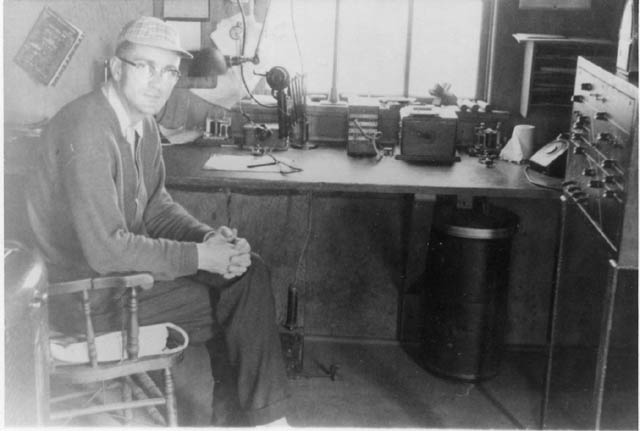
Operator W.Webster inside Canfield Jct. office March 1959
Wm.Common/Mercer Collection
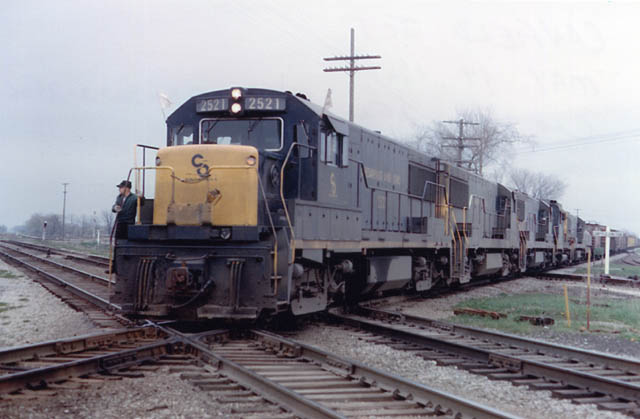
Extra C&O 2521-2506-2523-3023-2536 westbound on CN
Dunnville Subdivision
at Canfield Junction where the CN Cayuga Sub. parallels the CASO. May
14,1967
This detour featuring GE U Boats was caused by a ship striking the Welland
Canal Drawbridge the night before resulting in the train being routed
via Fort Erie rather than Niagara Falls requiring this maneuver at Canfield
Junction off the CNR via a connecting track to get onto the CASO/NYC double
track normally used by C&O on running rights. Note: White flags
and classification lights are displayed while running on CNR, something
not required on NYC tracks. Three photographs: Doug Page
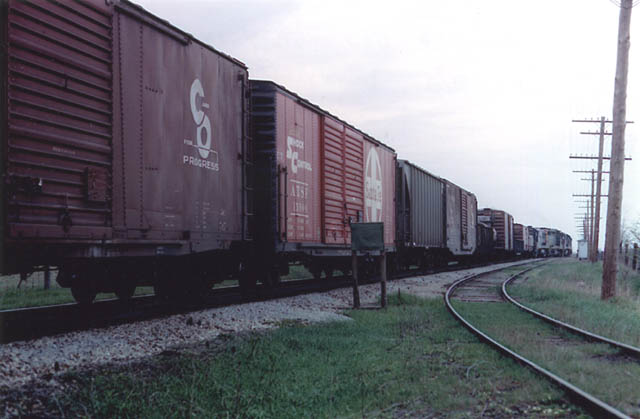
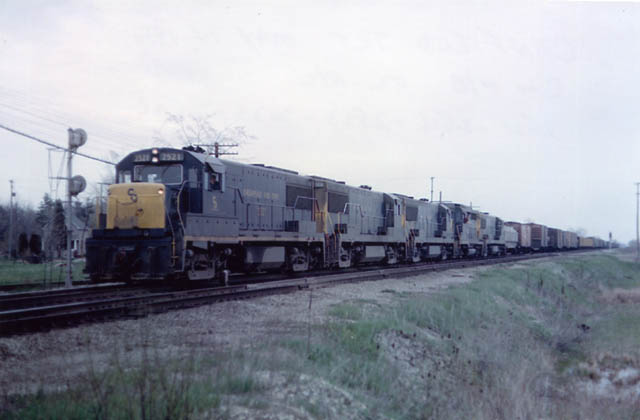
Heading west on the CASO double track main line where
it belongs.
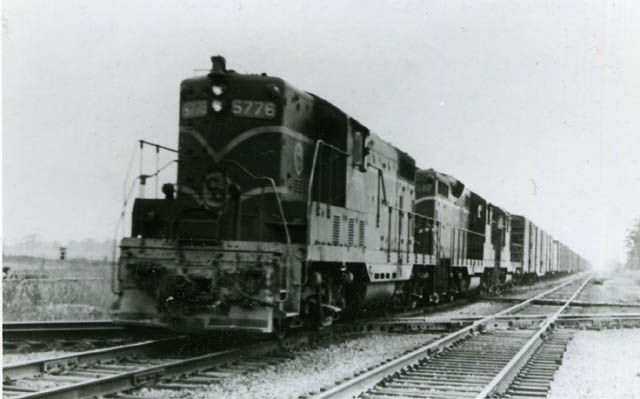
C&O 5776 leads two other GP's eastbound across the
diamond. c.1959
Wm.Common/Mercer Collection
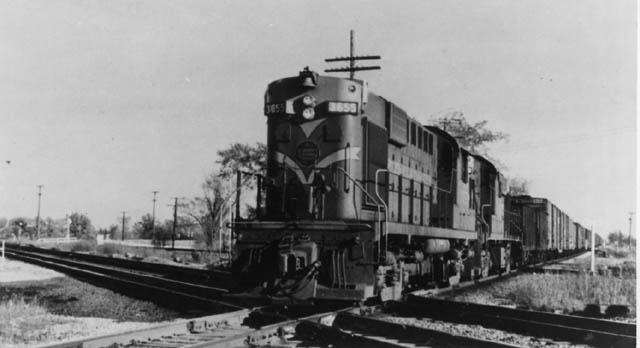
CN 791 engine 3655 an MLW RS-18 crosses opposite diamonds
on the Dunville Subdivision. c.1959
Wm.Common/Mercer Collection
E & O Junction
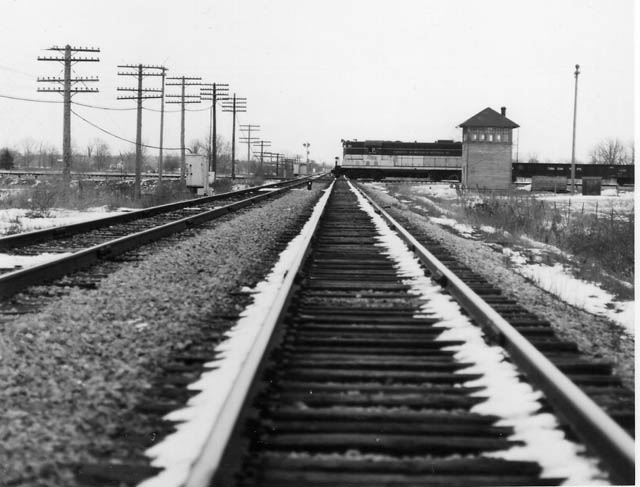
E & O tower named for TH&B predecessor Erie &
Ontario.
TH&B 75 northbound from Port Maitland to Smithville. CASO main line
in the foreground.
Above and below, February 16, 1973
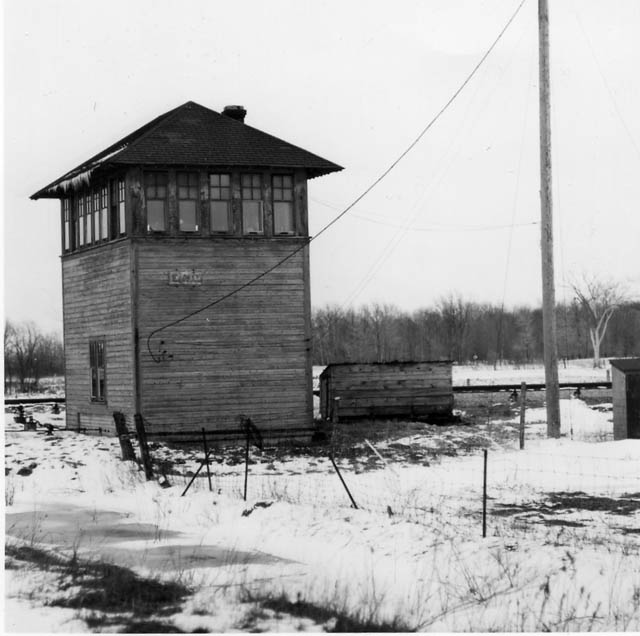
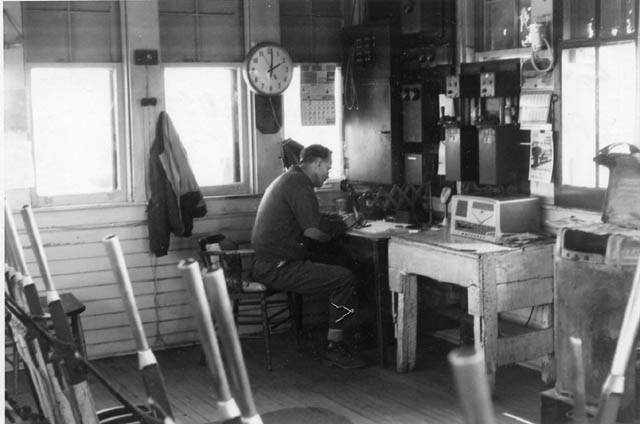
Inside E&O tower. Operator-leverman W.Webster. October
1971 BEM/collection
I personally did not work the *east end* except during my engineer training
days in May, June and July of 1980. However, I was familiar with the overall
operations,
having watched (as a fan) over several decades; and later as an employee,
with access to
Bulletins and other information. If my short stint as Trainee is any indication,
life on the east end must have been anything but boring !
Our round trip of May 30/31, 1980 is a pretty good example of Murphy's
Law.
Called at St Thomas for early afternoon, one look at the power, and then
at
the train size, and you'd want to go back home :
GP40-2's 4190 and 4231, with GP-7 5733 in between.
The train? Only 132 loads and the van . True to the C&O tonnage method,
we were only 10, 600 for those 132 loads. A tad light I would say!
In 1980, the fuel crunch was still on everyone's mind and we were constantly
reminded about use of dynamic braking versus stretch braking (among other
issues). However, dear ol' 5733 had no wiring that would enable it to
pass the d/b
Setup circuit from 4190 through to 4231. So d/b, at speeds above 25mph
at least,
were not going to be part of this trip.
Just getting the train across town and out onto the CR mainline was going
to
be a challenge. Trundling across the C&O's Kettle Creek bridge, squealing
by
the administration building and the backshop, then into the little dip
and
up the hill to the curved connecting track at BX tower was a little nerve
wracking. We were a little long to fit into the CR St Thomas yard, should
we
be delayed for any reason, but that didn't matter as it turned out. We
had a
Proceed indication on the dwarf signal at BALL, and so eastward we went,
onto the eastbound main and down the slight incline toward Yarmouth diamond
(CN Cayuga Sub). After the tail end informed us we were all on the straight,
and the Clear signal at Yarmouth was observed, it was time to get on her
and tackle the
next several miles up so-called Springfield Hill. I think we may have
gone
"over the top" at around 27 mph, nowhere near the 50mph allowable
speed limit.
And so it went, all through the day, 23-28mph on any uphill gradients,
and
35-40 on the downhill side. Never once did we reach maximum subdivision
speed.
Approaching Hagersville, we had a Proceed indication on the distant signal
to the diamond (CN Hagersville Sub). But as we drew near to the Absolute
(home) signal, the 3 of us (myself, regular engineer, headend brakeman)
noted that we had a Restricting signal. None of us clued in that this
was a
sign of trouble. Rather, we took it as a Proceed indication, albeit at
restricted speed. Turns out, the Burro crane had tied up for the day,
in the
remaining stub segment of the eastward passing track, but had neglected
to
realign the switch! And since that Absolute signal was still wired for
the
old days, it was simply doing it's job and indicating that we were indeed
lined into the passing track. Since we were down to 7mph, we were able
to
stop short of running into the Burro, however, we did not get stopped
in
time before actually entering the first few feet of the siding. We used
the
C&O channel on the handsets and explained to the tail end that we
must make
a reverse movement of about 60 feet WITHOUT ANYONE REALLY FINDING OUT.
Of course this is a rule violation, but on the other hand, no other trains
were
following us. Besides we were within the protection of the last signal
to
the rear, not that that's any excuse.
Continuing on our (merry) way, we got hooked at the Welland *funnel*
for
another work train, which cost us about 20 minutes. Then it was on to
Niagara Falls and a large delay at the east end of Montrose Yard. Seems
the
Tie Gang were replacing ties on the deck of Suspension Bridge, and only
the
westbound main was available for traffic. We sat here for over an hour,
awaiting train BUCP (Buffalo-Toronto/CP), the old KINNEAR, with it's usual
3 -unit lashup of TH&B geeps. Then the Chippewa local got the OK
to come off that branch and still we waited. And of course the main reason
for being stuck at Montrose, was our sheer length.
Finally we got moving, eastwardly on the westbound main all the way to
CP85.
Cruising past Clifton Hill and approaching the bridge, some wingnut had
driven through a gatearm and actually spun the gate so that it appeared
to
be stopping train traffic instead of vehicles. We could plainly see the
striped arm and the flashing red lights blinking at us. I looked at the
hogger and asked him if we should stop. " No, dammit, it's only a
$50 gate
for xxxx sakes". Like some B movie, we quickly made kindling of that
gate
and sauntered across Suspension Bridge. With the lead unit in full dynamic
and a 12 lb. reduction off the trainline, we came to a stop at US Customs
as darkness began to fall. The Conductor, by the way, reported the busted
gate to CR St.Thomas dispatcher.
We had some 75 or 80 cars to set off at CR Niagara Yard, and we ended
up
having to put those in 2 different tracks. By then, the rest of the crew
had
decided we weren't going any further that night, so we went to the motel
uptown for 8 hours rest.
After tying up the night before, we were on duty for 0800 (or something
close to it) May 31, 1980, to continue NI-42's "voyage" to Buffalo,
and back
to St Thomas. We stayed overnight in a motel not far from the downtown
border crossing near the Rainbow bridge. In the morning, our "crew
caller"
was the hotel front desk clerk, who gave us the customary 2 hour 'call'
for duty
via the room telephone.
After breakfast, we taxied to Conrail's Niagara Yard, got our new daily
supply of CR Bulletin's and then had the Yardmaster drive us halfway down
the yard lead to our power. Naturally, the units were shutdown for fuel
conservation, so it would be a few minutes before we could think about
an
air test. After the preliminaries, we were set to leave, and contacted
both the
Yardmaster and the Niagara Branch dispatcher.We got permission to exit
the
yard via crossovers known as The New Way. After opening up and pulling
the
tail end clear of the switch, the crossovers were again lined normal,
and off we went to Buffalo. Since this is 1980, we are no longer operating
in/out of Bison Yard, but rather the B&O Buffalo Creek Yard.
First we must travel along the Niagara Branch of CR, to the connection
point
with the Beltline. Here, we will turn east and run the Beltline down to
it's
eastern/southern most point, which is Tower 49 adjacent to Central Terminal.
After tip toeing across the Buffalo/Cleveland mainline, we will continue
on
the Buffalo Creek Secondary to FW Tower, then veer right ( or southwest)
and
continue along to a point within view of CP DRAW, except we will make
a hard
left turn and enter the B&O yard. Since we were only 35 or 40 cars
now, we
could fit between 49 and FW without blocking CR or NS. We sat at FW for
3
conflicting moves -
an N&W eastbound arriving from Bellevue with 6143 - D&H 7320 -
D&H 7317 and
D&H 758; and a pair of CR transfer moves, each with one GP-8 and a
GP-35.
Buffalo Creek Yard was a pretty rundown place by 1980. Most of the tracks
had a bad list to the left or right, owing to decaying ties and water
problems. It was also in the crosshairs of plenty of pollution from Republic
Steel
Corp on the east side, and the sprawling complex of Bethlehem Steel and
Donner Hanna Coke on the west and south side. Still it was part of the
Chessie family, that conglomeration of C&O, B&O and WM, and we
were happy to
be on family soil, such as it was. Hard to believe that a few years later,
it would be sold to the growing shortline operator Genessee & Wyoming,
becoming their Buffalo & Pittsburgh RR.
With our schedule now off by 8 hours, we didn't have long to wait to
get
ready for the outbound trip as ST-41. The cars were air tested by the
yard
air system, so all we did was pull into a track with our inbound train,
run
back to the north (west) end with lite power, and tie on to the outbound
train. This of course meant we didn't wye the power, but we still ended
up
with a GP40-2 in the lead. A yard job took our van off the inbound cars
and
set it over to a vacant lead track, so all we had to do was double to
it
when ready. And soon we were ready. Mind you, it was after 12 noon by
now.
We told the GYM we were all set to leave and he in turn contacted CR to
see
if we could sneak out into the Secondary at River Bridge. No such luck
this day!
A derailment has now occurred on the CR Beltline just beyond Tower 49.
Not
much is moving anywhere, except on the NS and CR main's. While we await
our
fate, another N&W train glides by, pulled by SD45 1704 and ATSF 5205.
But
still we wait. The Yardmaster suggests we push back into the lead because
he
now has word this may take several hours. While everyone else goes for
a
coffee in the dilapidated yard office, I sit on 4231 and watch a Republic
Steel SW-1 try and shove 2 loads of coke up a 5% grade to the blast furnace
about 1/4 mile away. Its a warm day and you can hear that puppy roaring
over
the drone of the idling EMD's.
After 90 minutes, some good news. We will be leaving soon, however, we
will
be headed to the border on a very different routing. The engineer and
conductor come back on board and are busily comparing Bulletins and personal
notes. What could the solution be, I wonder to myself. Turns out, we are
being sent home via the City Branch and WARWICK, apparently using part
of
the old routing from the 50s and 60s when C&O would terminate/originate
at
Canada Yard on the Erie. I thought to myself, I knew I should have joined
a Rare Mileage Club!
Recap -
As Engineer Trainee, I am assigned to the East End during May, June &
July
of 1980, making my [ CR] required 30 trips for familiarization purposes.
May 30th, we go east from St Thomas on train NI-42, a GP-7 in between
a pair
of GP40-2's, and 132 cars. A wrong switch at Hagersville, a delay at Montrose,
and a large setoff at CR Niagara Yard, all contribute to tieing up at
Niagara Falls NY,
30 miles short of our destination. The next morning we continue to the
B&O Yard,
but are delayed on the outbound portion, owing to a derailment on CR's
Beltline.
Around 1400, the Engineer explains to me what has happened, and how the
powers that be plan on getting us homeward-bound. From the B&O yard,
we will start off via the usual route, passing River Bridge and FW. However,
at FW tower,
we will diverge to the northeast (versus north) and use an old
stretch of EL (Erie) trackage that skips by the former East Buffalo Yard,
also referred to as Canada Yard. Prior to Bison Yard, this was the facility
where C&O trains would originate/terminate. In the middle of this
property
is a wye that connects to the City Branch, so-named because it crosses
through the north central portion of Buffalo, mostly overhead of other
trackage and streets. In fact it crosses overhead of the Buffalo/Cleveland
main just east of Central Terminal, and also crosses overhead of the old
NYC
West Shore trackage that connects to the Beltline immediately north of
Central Terminal. At this point in time, the West Shore was used, among
other things, by CP-CR train CPBU and BUCP when arriving/leaving Frontier
Yard.
Eventually the City Branch connects to the DL&W line that came from
Bison
(and which crosses overhead of the NYC right at Broadway Ave and the throat
of Frontier), and this location was named WARWICK. The City Branch, on
older
maps, shows as double track; however by 1980 ( and probably sooner..?),
it
was a twisting single track, using portions of either rail depending upon
local industry needs. This was entirely Other Than Main track (to use
a
Canadian term), meaning we had to be on the lookout for incorrectly lined
switches, and other engines or equipment. We did pass one industrial job,
with an SW-9 , but he did not block us.
At WARWICK, we had to stop clear of the former DL&W and go to the
phonebox
to get verbal permission to open the switches and enter the Main. I don't
really recall what the name of this piece of track was, however, it was
mainly used by N&W trains between Bison and Black Rock. After gaining
the
main and closing up behind us, the speed was 30 mph until we dropped down
to
the former Black Rock yard of EL (DLW); we had to wait for a CR transfer
that was moving across the International Bridge ahead of us, before we
too
headed for Canada.
It was now after 1600 and there were rumbles about eating somewhere at
Welland or beyond. When the Conductor ( who rode the head-end from the
B&O
Yard) came back from Customs, he said we were being asked to pull up far
enough so that a piggyback load could be inspected. Great, more delays!
It took this person from Customs about 45 minutes, to drive over near
the
tail end and check out this trailer ( I have no idea what was supposed
to be
in it). Eventually, we were released and got permission from CR St Thomas
dispatcher to use the Fort Erie Branch westward.
I was surprised at how good the track was, and we sailed along at the
permissible speed of 30mph. We got to the Welland tunnel and accepted
a
Medium Clear signal to move from the Branch to the Main and we were off
and
running towards home. By this time, the current day's NI-42 was already
at
Niagara Yard. We had the railroad to ourselves and the crew were about
to
take full advantage of that!
Wouldn't ya know it, we got permission to pull the tail end west of the
diamond at Canfield, detrain the Conductor and his brakeman, then backup
again and go for beans at the diner located at Highway's 3 and 56 ! My
old
stomping grounds, again!!!
It was dark (after 2000) when we left Canfield for St Thomas. I was pretty
whipped and was not looking forward to driving for another hour to get
home
to Chatham. However, I had been promised by the Road Foreman of Engines,
2
days earlier, that I could have 3 days off before another trip.
It was kinda neat running under the cover of night as we accepted Clear
block signals all the way . I had never been on this stretch of track
except
during daylight. We pulled up in front of the mammoth station and office
building in
St Thomas and were promptly taken off the train by the C&O crew caller
in a
company van.
The Talbot night yard crew were on hand to actually yard the train ( this
was a regular occurrence in those days). We were a total of some 14 hours
on
duty, under 2 separate time tickets of course ( NI-42 Nia Yard to Buffalo,
and ST-41 Buffalo-St Thomas).
Having spent that much time in the cab, my vehicle felt like it had 4
square
wheels, compared to the EMD gliding along the 127 lb rail of the old NYC
!
What an adventure.
In May 1980, during my training trips as engineer, I sat in the chair
of
GP40-2 4297 as we crested the little ridge coming off the Grand River
bridge,
and I could see the Absolute mast way ahead at Canfield.
Here I was, on what was then Conrail, sitting behind the throttle,
and rattling over those very diamonds where I used to stand all those
years.
Talk about coming full circle.
By 1980, the usual course of events saw only 1 train per day on the East
End. NI-42 and CG-41 were the order of the day. By then, Bison Yard
was no longer being used by C&O; instead the Canadian District trains
terminated/originated at the dilapidated B&O Buffalo Creek Yard. I
could
write half a book on this place, but I won't. Once in a great while, if
things got bogged down, an Extra train was called. It was usually symbolled
BF42 and ST41 ( for Buffalo, and St Thomas). For the most part it would
only
run as far as CR's Niagara Yard in Niagara Falls NY.
Sometimes it wouldn't even get a symbol; they'd just call it Bridge Turn.
I got called one day for just such a move; great, 2 of the Canadian GP7's
and 55 cars for Niagara Yard. Coming back, we had over 70 cars, and man,
those poor geeps got a workout. CR's Canada Division Mainline was still
50
mph in 1980, but we never really got to that speed all day ( it was a
short
turnaround, down and back in one continuous trip).
Considering that a few years later, CN and CP would buy the CR assets
within
Canada, there sure was a lot of trackwork going on in the spring and summer
of 1980. We were constantly running single track, either one main or the
other, all the way from St Thomas to Welland. Only on the weekends, when
the
gangs weren't out there, did we actually use the 'proper' track in either
direction.
By this time, C&O ran these trains via Niagara Falls. However, they
still
retained trackage rights via Fort Erie. And one day, on the homeward
journey, I was fortunate enough to bring a train across the International
Bridge and on to Welland via the Fort Erie Branch. We got delayed by Canada
Customs, some lady inspector just had to open the doors on a truck trailer
that was 5 cars from the tail end. So we pulled cleared of all the yard
leads, parallel to the CN yard, and waited 45 minutes while she checked
for.....whatever !
Up until 1976, certain eastbounds would only travel from St. Thomas to
NYC/PC yard at Montrose (Niagara Falls, Ont). From there, C&O Canadian
crews
would take the cars to the respective connecting railroad in Niagara Falls,
NY. These ' Montrose Transfers ' were so-called outpost assignments. They
were bid jobs, and any vacancies were handled off the St. Thomas spareboard.
You either deadheaded via an eastbound, or you took an NYC passenger train
to get to Montrose and cover the vacancy. Of course if you took the train,
you had to taxi from Welland to The Falls.
Buffalo-bound trains always went via the Fort Erie Branch and
terminated/originated at the Erie's East Buffalo Yard, and then later,
at Bison Yard when it opened.
In 1976, of course, CR was created, and the necessity of running these
transfers to LV, PC and E-L was eliminated. All the traffic then went
to
(PC) Niagara Yard.
Additional trackage rights were negotiated in order to use CR's Niagara
(NY)
Branch between Niagara Falls and Buffalo. This allowed NI-42 and CG-41
to
make a circuitous trip, setting off or lifting at Niagara Yard enroute
to/from Buffalo.
In the late 80s, these trains were renumbered, under CSX plans, to R320
and
R321. They would carry these numbers until the final day in February of
1996.
This closes the Tattered Little Note Book.
Part 1 Part
2 Part 3
|
